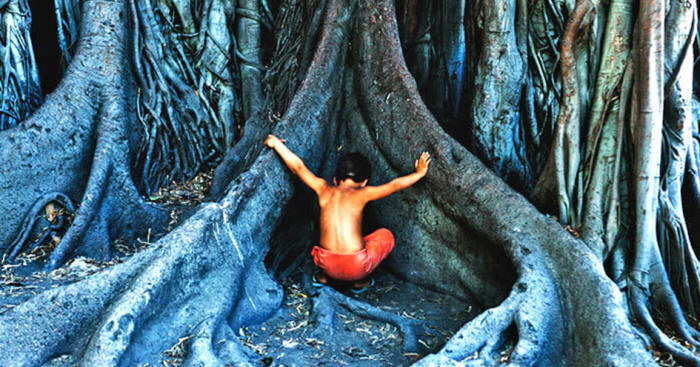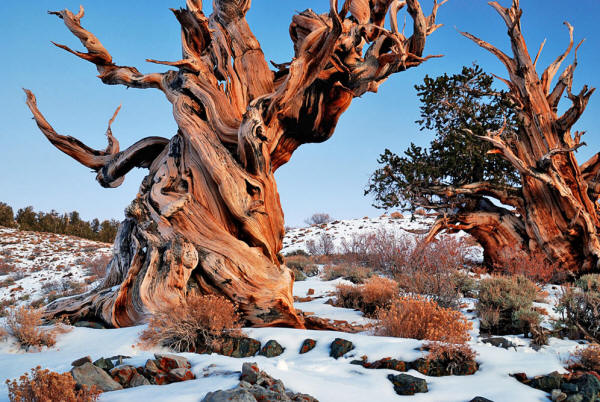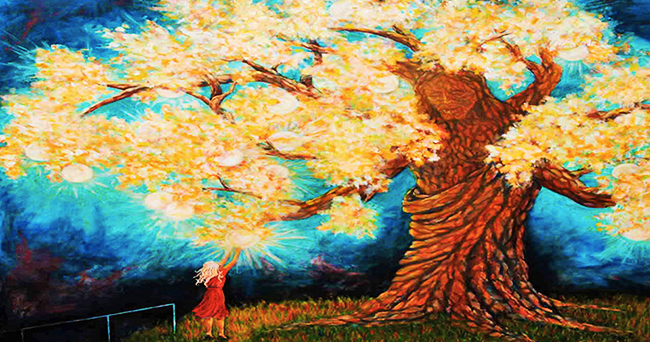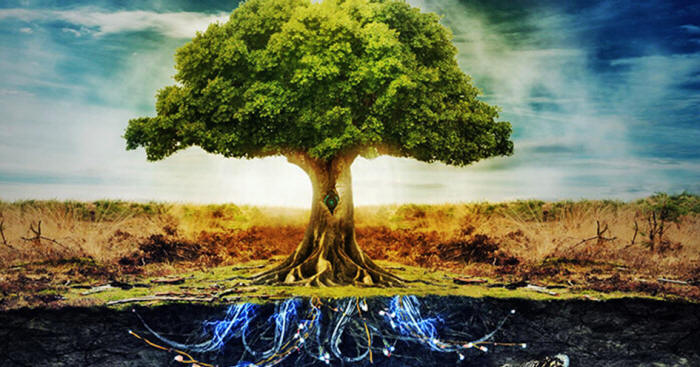|

by Jocelyn Mercado
November
06, 2017
from
UpliftConnect Website

The Link
Between Humans and Trees
Trees are considered sacred in many
cultures.
Tree worship, in one form
or another, has been practiced, almost universally, by ancient
peoples in every corner of the globe.
It is no wonder that trees have captured the human imagination
since the beginning of time.
Their strength,
deeply rooted in the Earth, is an inspiration.
Their trunk and
branches are a wonder of nature because they stand sturdy and
impenetrable most of the time, yet they can flex and sway with
the wind when needed.
The whisper of a breeze in their leaves, or the sight of ants
marching in a straight line up or down their trunks, remind us
of the magic of nature that trees embody.
They live for
hundreds or even thousands of years, and so we revere
them as keepers of past secrets and sentinels of the future.

Methuselah
Until
2013, Methuselah, an ancient bristlecone pine
was the oldest known non-clonal organism on Earth.
While Methuselah still stands as of 2016 at the ripe old age
of 4,848 years in the White Mountains of California,
in Inyo National Forest, another bristlecone pine in the area
was discovered to be
over 5,000 years old.
Methuselah and its unnamed senior pine's exact locations
are kept a close secret in order to protect them..
Source
Watching their cycles of
growth - shedding of leaves, and re-flowering in the spring - people
have long perceived trees as powerful symbols of life, death, and
renewal.
Since the beginning of
time, humans have had a sense that trees are sentient beings, just
like us; that they can feel pain, that they bleed when they are
hurt.
Trees even look like us.
People have a trunk; trees have arms.
And so we innately feel a
deep connection to them.

Some humans have a sense
that trees are sentient beings,
just like us.
Many people say they can feel a tree's vibrational energy when
placing their hand upon its bark. With their deep roots, trees carry
significant grounding energy.
We naturally feel peace
and serenity when walking in the shade of trees or on a forest
trail.
Trees Help Us
Every Day
A recent study shows that trees remove so much pollution from the
air that they,
"prevented 850 human
deaths and 670,000 cases of acute respiratory symptoms in 2010
alone."
When an insect called the
Emerald Ash Borer killed off a significant number of trees in
the American Midwest in the 1990s and 2000s, rates of human death
from cardiovascular and respiratory illness increased.
More difficult to quantify is the psychological effect that trees
have on people.
People who spend time
outdoors, or even those who have access to windows looking out at
trees, have been shown to have better health than those who do not.
The Universal
Tree of Life - Both Ancient and Modern
The concept of a Tree of Life, often symbolizing the
connections between all life forms, is found in many religions and
philosophies, dating back as early as
ancient Egypt.
The Egyptian tree of
life symbolized creation and represented the chain of events
that brought everything into existence.
Fast forward to modern science...
The tree has become the
quintessential symbol of biological evolution, as its ever-branching
image poignantly depicts the unmistakable interconnections between
all living species on the Earth.

People who spend time outdoors
have been shown to have better health.
The Tree Leaf
and Eternal Life
Consider this beautiful commentary from
Thich Nhat Hanh reflecting on a
tree leaf:
I asked the leaf
whether it was frightened because it was autumn and the other
leaves were falling.
The leaf told me,
"No. During the
whole spring and summer I was completely alive. I worked
hard to help nourish the tree, and now much of me is in the
tree.
I am not limited
by this form. I am also the whole tree, and when I go back
to the soil, I will continue to nourish the tree. So I don't
worry at all.
As I leave this
branch and float to the ground, I will wave to the tree and
tell her, 'I will see you again very soon'."…
That day there was a
wind blowing and, after a while, I saw the leaf leave the branch
and float down to the soil, dancing joyfully, because as it
floated it saw itself already there in the tree.
It was so happy.
I bowed my head,
knowing that I have a lot to learn from the leaf because it is
not afraid - it knew nothing can be born and nothing can die.
Cultural
Beliefs about Trees
Trees are considered sacred in virtually every place where humans
have settled. There are many profound beliefs surrounding trees that
people have held for millennia.
Here are some interesting
and touching examples:
For the
Sng'oi people of Malaysia, a
person and a tree can belong with each other, and this
relationship is maintained for life. Certain trees and certain
people belong together.
When a person belongs
with a tree, they also belong with its offspring:
any trees that
grow from the seeds of the first tree, no matter how far the
seeds may scatter.
The Sng'oi people
call upon their intuition to know which child trees have
sprung from which parent trees.
The World Tree is
said to dwell in three worlds:
-
its roots reach
down to the underworld
-
its trunk sits on
the Earth
-
its branches
extend up to the heavens
Many cultures share a
belief that this tree is the
Axis Mundi or World Axis
which supports or holds up the cosmos.
For the Mayan
peoples, the Axis Mundi was a massive
Ceiba (in other cultures, it is
called Kapok) tree that stands at the center of the world.
The Mayan beliefs
reflect that human souls first came into being as the sacred
white flowers on the branches of the Ceiba tree.
Souls of the dead
Mayan ancestors rose from the roots of the Axis Mundi, up
through its branches and into the celestial realms.

Trees literally and metaphorically
represent connection and the cycles of life.
In Germanic regions, it was believed that mankind was created
from tree trunks, echoing the perception that people and trees
have much in common.
In Sweden, some trees were considered 'wardens' and could guard
a home from bad luck. The warden was usually a very old tree
growing on the lot near the home. The family living there had
such great respect for the tree that they would often adopt a
surname related to the name of the tree.
A well-known sacred tree in Norse mythology was
Yggdrasil, a giant ash tree
that was said to link and shelter the nine worlds that were
believed to exist.
In Irish and English folklore, fairies would be found wherever
Ash,
Oak, and
Hawthorne trees grew together.
Hawthorn trees were
regarded as a powerful symbol of protection, and were often
planted near houses to ward off lightning, as well as evil
spirits.
On the dawn of
Beltane, it was believed
that women who bathed in the dew from a Hawthorne blossom would
become beautiful, and men who washed their hands in the dew
would become skilled craftsmen.
Buddhists have a deep reverence for the
Bodhi tree - a type of fig
tree with heart-shaped leaves - beneath which the Buddha is said
to have meditated for 49 days; trying to reconcile his mind to
the fact that there was suffering in the world.
On the 49th
day, he stood and thanked the tree for providing shade for him,
and in that instant he attained enlightenment.
Today, in the same
location where the Buddha is believed to have sat, there grows a
descendant of that same Bodhi tree. Buddhist myths say that the
tree will live there until the world is destroyed, and the place
where it grows will be the last place to be destroyed.
And when the world is
reborn, that site will be the first place to appear.

Tree mythology across many cultures
describe trees connecting the different worlds.
The villagers of
Piplantri, in Rajasthan, India,
celebrate the birth of each little girl by planting 111 trees in
her honor.
The entire village
works together to plant and care for the trees. This tradition
not only ensures that the environment will be able to support
the increasing population of the village, but it has also
brought harmony, and a drop in crime, to the village.
In Malaysia, people maintain a very intimate relationship with
trees.
"There is a
practice of tree planting around houses to the extent that
the walls and wooden structures are allowed to give way to
the roots of creeping plants, purposely sown at the bases of
these structures."
The graveyards in
Malaysia are covered so thickly with trees that the entire
grounds are cool and sheltered from the tropical sun.
The trees are allowed
to take root into the graves and it is said that the trees
whisper prayers to the creator, asking for forgiveness of past
transgressions of those buried there.
These are just a few of
the many ways trees have been honored throughout time.
In today's age, let's not
forget the significance of trees, their history and how they are
essential for human life.
| 






